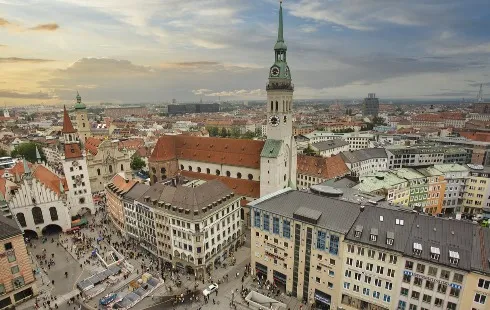
Gonadorelin Peptide: A Gateway to Understanding Endocrine Dynamics
Section: Science
 In 1938, the Nazis orchestrated the demolition of the magnificent Munich Synagogue located in the city's old town. The grand structure, which had stood proudly since its completion in 1887, fell victim to Adolf Hitler's personal command. Eleven years later, as the scars of war were still healing, the partially adorned stones from the synagogue were unwittingly repurposed for the repair of an Isarwehr (weir) during construction work. Now, during recent excavations, these fragments have resurfaced, posing an important question: what should be done with these tangible remnants of a painful history?
In 1938, the Nazis orchestrated the demolition of the magnificent Munich Synagogue located in the city's old town. The grand structure, which had stood proudly since its completion in 1887, fell victim to Adolf Hitler's personal command. Eleven years later, as the scars of war were still healing, the partially adorned stones from the synagogue were unwittingly repurposed for the repair of an Isarwehr (weir) during construction work. Now, during recent excavations, these fragments have resurfaced, posing an important question: what should be done with these tangible remnants of a painful history?
On the 8th of June 1938, Emanuel Kirschner, the retired cantor of the Munich Main Synagogue, made a final appearance at the request of the Israelite Religious Community's chairman. It was the last service ever held in the splendid synagogue before the city authorities, through a morning notification, informed the Jewish community that the building would be demolished the following day. The order had come directly from Adolf Hitler himself.
The farewell service, which involved the solemn removal of the Torah scrolls from the premises, stands as a poignant moment in Munich's Jewish history. Emanuel Kirschner, in a letter, described the "deeply moving" atmosphere within the synagogue. He wrote of elderly and young congregants, tearfully embracing the Torah bearers as they received the displaced holy scrolls. This improvised act of worship marked the most emotional moment of the occasion. The next day, construction workers from Leonhard Moll's firm began the demolition process, leaving no trace of the synagogue behind. Within a month, a parking lot occupied the space where the sacred structure once stood.
For decades, the fate of the synagogue's remnants remained shrouded in mystery--until now. During recent renovation work at the Großhesseloher Wehr, a series of massive stone blocks were unexpectedly unearthed from the depths of the Isar River. Workers from the Munich City Utilities (SWM), upon discovering intricately sculpted artworks and Hebrew inscriptions on the stones, promptly alerted the State Office for the Preservation of Historical Monuments (LfD). Subsequently, the Jewish Museum was also involved. It has now been determined that these stones, weighing a total of approximately 150 tons, are fragments from the interior of the Munich Main Synagogue. Among them is a monumental stone tablet, weighing 600 kilograms, that once adorned the Torah ark and displayed the Ten Commandments in Hebrew.
Walter Irlinger, representing the State Office for the Preservation of Historical Monuments, described the find as "sensational." He underscored its significance, both from a religious and historical standpoint, as well as the unexpected nature of the discovery. The story of how these stones ended up in the Isar River has been reconstructed. According to the Munich City Utilities, in 1956, the Großhesseloher Wehr underwent repairs following a flood, utilizing rubble and large stone blocks, including remnants from the demolished synagogue. The repair work was contracted to the Moll company, which had apparently stored the remnants on its premises.
The revelation that fragments of the revered synagogue, including the intricately adorned tablet displaying the Ten Commandments, were unceremoniously submerged in the Isar River for repair work seems inconceivable from a contemporary perspective. However, Bernhard Purin, Director of the Jewish Museum, describes it as a "typical example of the inadequate handling of the past during the post-war period, which was particularly evident in Munich."
Charlotte Knobloch, President of the Jewish Community of Munich and Upper Bavaria, speaks of the synagogue's "double destruction." She emphasizes that it was first obliterated during its demolition in 1938 and again when its remains were repurposed for construction work. Given this historical context, Knobloch states, "At the moment, my dismay outweighs my joy." Knobloch herself retains memories of the main synagogue, which she visited as a child with her family. She recalls the profound impact it had on her, describing the building's beauty and the happiness exhibited by people as they entered and departed the synagogue.
Previously, it was believed that only around one kilogram of debris from the synagogue had survived, carried to the United States as a memento by a Jewish Munich resident who fled during the war. Suddenly, however, there are tons of fragments that have been transported to an SWM site. Walter Irlinger explains that the initial step is to inspect and store the fragments appropriately, followed by analysis and documentation, a process expected to span several years.
Bernhard Purin anticipates that additional fragments may emerge during the ongoing work at the weir. He harbors a modest hope that perhaps a partial reconstruction of the Torah ark can be achieved. What will become of the stones following the extensive analysis remains uncertain, including issues surrounding ownership. Walter Irlinger states, "We cannot comment on ownership at this time," while Museum Director Purin alludes to the "moral claims" of the Jewish community.
Beth Shalom, Munich's liberal Jewish community, has already expressed its belief that it represents the spiritual successor to the former main synagogue. The community's chairwoman, Eva Ehrlich, hopes that at least one of the discovered stones will find its way to their community. Charlotte Knobloch, representing the Jewish Community, emphasizes her desire for the stones to be prominently displayed, encouraging contemplation by the public. She envisions these fragments serving as a poignant reminder of the history of the main synagogue and the emotions--both joy and sorrow--that are intertwined with it.
"The New Synagogue," as described in the 1887 Allgemeine Zeitung des Judenthums, "according to experts in architectural matters, is an ornament to the city." The inauguration of the synagogue was celebrated as a significant cultural event in Munich's history. Its construction was necessitated by the city's growing Jewish community, which had been granted the prominent plot on Herzog-Max-Straße near Stachus by King Ludwig II. In just three and a half years, at a cost exceeding 1.3 million marks--an astronomical sum at the time--the third-largest synagogue in Germany was built, accommodating 1,000 men and 800 women. It was a magnificent structure, both internally and externally, serving as a symbol of hard-fought Jewish emancipation.
Bernhard Purin, Director of the Jewish Museum in Munich, explains, "The synagogue symbolized the civic equality of Jews. They were no longer compelled to celebrate their rituals covertly in backyards but became integral to public life." Designed by Albert Schmidt, the Munich Main Synagogue stood in the heart of the old town, shaping the cityscape. It stood alongside the towers of the Frauenkirche, forming an iconic postcard image. However, the destruction of the synagogue was as emblematic as the structure itself. It was one of the first two German synagogues to be demolished on the 9th of June 1938, five months before the nationwide Kristallnacht, during which over 1,400 synagogues, prayer rooms, and other Jewish gathering places were stormed and destroyed.
Only in 1969, as a remembrance of the Main Synagogue, did a memorial stone by sculptor Herbert Preis find its place on Herzog-Max-Straße. It stood as one of Munich's earliest public monuments, serving as a reminder of the destruction of Jewish
life during the Nazi era. In 1999, the plot of land that once held the synagogue was sold for the expansion of the Oberpollinger department store. The proceeds from the sale contributed to the construction of the new Main Synagogue on Jakobsplatz, which was inaugurated in 2006.
Article translated and rewritten from SZ

Section: Science

Section: Health

Section: Arts

Section: Health

Section: Science

Section: News

Section: News

Section: Health Insurance

Section: Health

Section: News
Health Insurance in Germany is compulsory and sometimes complicated, not to mention expensive. As an expat, you are required to navigate this landscape within weeks of arriving, so check our FAQ on PKV. For our guide on resources and access to agents who can give you a competitive quote, try our PKV Cost comparison tool.
Germany is famous for its medical expertise and extensive number of hospitals and clinics. See this comprehensive directory of hospitals and clinics across the country, complete with links to their websites, addresses, contact info, and specializations/services.
The granddaughter of Claire Zachanassian makes a return to Güllen, the impoverished hometown of her late grandmother, for a performance. Having never fully engaged with her grandmother's past, she is eager to finally discover Güllen. The sound of her last name stirs the entire town into action.



No comments yet. Be the first to comment!